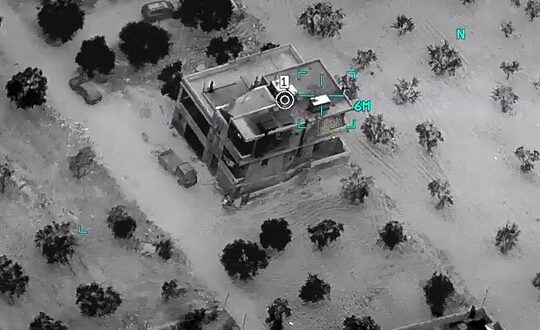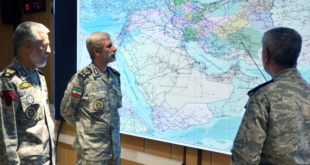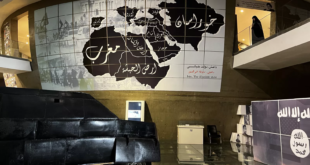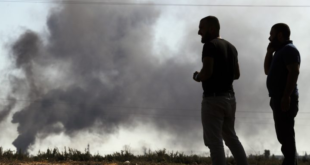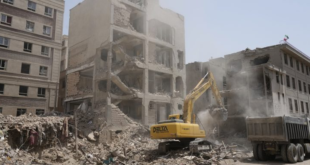Last week, U.S. President Joe Biden ordered a team of U.S. special operations forces to carry out a raid in northern Syria that is now stoking legal controversy. The mission targeted a residential compound where Islamic State leader Abu Ibrahim al-Hashimi al-Qurayshi had been holed up with his family and civilian neighbors. By the end, al-Qurayshi and a disputed number of civilians were dead.
As Washington Post reporter Miriam Berger has explained, since Syria did not consent for U.S. forces to carry out the raid, Biden’s order arguably violated the charter of the United Nations, which limits a state’s ability to carry out attacks on foreign soil. The United States’ justification for doing so in its hunt for transnational terrorists rests on a highly disputed legal theory that suggests a state like Syria foregoes its sovereignty when it is “unable or unwilling” to apprehend such individuals itself.
The strike runs afoul of U.S. domestic law as well. The Biden administration has argued that the 2001 law allowing the U.S. to battle al-Qaida using military force can also be extended to the Islamic State. But this rationale stands on shaky ground, considering the well-documented split between these groups. And, as I’ve argued often before, the very concept of targeted killing outside of active conflict zones can be viewed as a form of illegal extrajudicial execution.
That being said, the approach taken by the Biden administration in the al-Qurayshi raid differs in important ways from the targeted killings American have become so accustomed to reading about in the news and presents genuine benefits for international justice and counterterrorism efficacy that are worth examining.
First, this mission was carried out by a team of special operations forces, rather than a drone, which made collateral damage less likely. Second, the explicit intent was to capture al-Qurayshi, not to kill him, according to the head of the U.S. Central Command, Gen. Frank McKenzie. Since al-Qurayshi killed himself with an explosive vest, it is unclear whether the U.S. mission would have otherwise ended in a killing or an arrest. But arrest was at least possible and desired, unlike in situations where drones are used to conduct what are essentially extrajudicial executions from the sky.
Besides being more consistent with human rights law, there are two strong tactical reasons to prefer this type of operation over targeted killings with drones. The first is that ground operations dramatically reduce deaths by mistaken identity, while also limiting the possibility that innocent civilians will be caught in the crossfire. According to a 2014 report from the Center for Naval Analysis, drones have a 27.5 percent rate of civilian casualties per operation, whereas other types of operations have only a 7.5 percent civilian casualty rate.
Compare this event, for example, to the misbegotten drone strike that hit a car in Kabul toward the end of the U.S. withdrawal from Afghanistan last August. Instead of killing a terrorist carrying explosives, that strike killed an aid worker carrying tanks of water. Aerial intelligence was simply not able to distinguish the driver’s true identity, relying instead on guesswork and best estimates from human intelligence on the ground.
The approach taken by the Biden administration in the al-Qurayshi raid presents genuine benefits for international justice and counter-terrorism efficacy that are worth examining.If the al-Qurayshi home had been targeted in a similar aerial strike, the number of “acceptable” casualties would have been decided by a drone pilot and military lawyer, who would have made a judgment call as to when the number of civilians in the compound was low enough to justify a “proportional” strike. Instead, the ground team was able to reduce the odds of collateral harm even further by clearing the area of some civilians in real time—first calling on them to evacuate and then assisting many in leaving their homes. Had al-Qurayshi not detonated his own explosive device, it is possible no civilians would have died.
While global data is scarce on the overall historical ratio of civilian casualties resulting from commando raids as compared to drone strikes, it stands to reason that in raids, armed actors are likelier to follow rules of engagement more associated with law enforcement or SWAT teams rather than urban warfare, and in doing so would take greater pains to protect innocent bystanders. Indeed, U.S. President Joe Biden has explained that he used ground troops rather than aerial munitions in the al-Qurayshi raid specifically for this purpose.
The second distinguishing feature of this raid is that it was designed to capture—not kill—the suspect. This is important, because while both ground and aerial missions can aim to kill, only ground missions can aim to capture their targets. And missions that aim to take a suspect into custody are arguably far better for dealing with suspected war criminals like al-Qurayshi, because a detained suspect yields three advantages over a corpse.
First, a suspect in custody can be interrogated. For example, during the U.S.-led coalition’s campaign against the Islamic State in 2015, British special forces apprehended multiple high-level ISIS operatives in advance of aerial attacks, both as a tool of psychological warfare and also in order to gain actionable intelligence to support the upcoming operations.
Second, a suspect in custody can be rehabilitated. Saudi Arabia has been a master of this approach, sending moderate clerics to “counter-indoctrinate” jihadists, who are then offered a fresh start. Though imperfect, this strategy has seen a very low recidivism rate and has even spawned a global movement of rehabilitated former jihadists who are using their voices to challenge jihadist ideology.
Third, a suspect in custody can be tried and convicted as a war criminal—and a war criminal al-Qurayshi arguably was, if the allegations against him are borne out. He is believed to be responsible for the continuing violence against the Yazidi people of northern Iraq, including the sexual slavery of Yazidi women and girls, which the U.N. has called a genocide.
This approach of apprehending and trying terror suspects gets less press than the U.S. campaign of targeted killings by drone, but it has often been used by the United States. For example, in 2013, U.S. Delta Forces apprehended alleged al-Qaida operative Abu Anas al Libi during a raid in Libya and turned him over to a New York court, where he was indicted for his involvement in the bombings of U.S. embassies and other al-Qaida operations. Though al-Libi died in prison before his trial, one could argue that his imprisonment and indictment rightfully treated him like the criminal he was. And this strategy of criminalization over decapitation is also more effective in delegitimizing acts of global terror than lethal operations, which often have a blowback effect.
There have been important missed opportunities in this regard as well. Had al-Qaida founder Osama bin Laden been captured rather than killed by the Navy Seal team that stormed his Pakistani compound in 2011, he could have been tried as a criminal at an ad-hoc international tribunal similar to those set up by the U.N. Security Council for the Bosnian War, the Rwandan genocide and the assassination of Prime Minister Rafic Hariri in Lebanon. As former prosecutor and human rights law professor Geoffrey Robertson noted at the time, trying bin Laden would have contributed to international justice and the promotion of rule-based order—particularly if the statute of the court had included Islamic law as well as international humanitarian law and incorporated Islamic jurists as well as Western-trained ones.
There are all kinds of legal questions about deploying special operations forces on the sovereign territory of other nations. But the type of operation likeliest to be the most justifiable, and least politically suspect, is an operation like the al-Qurayshi raid: one that treats a specific criminal as a suspect who should ideally be captured rather than killed, while protecting nearby civilians, with the eventual aim of trying the apprehended suspect in a court of law.
The obvious downside to operations like this is that troops face greater risks in ground operations than they do while piloting a drone remotely from Colorado or Arizona. But the al-Qurayshi raid, like the bin Laden raid, shows that a well-trained special ops team can come and go from a mission like this with minimal or zero casualties. Given the gains, Biden would be wise to make this mission a model for future counterterror operations.
 Eurasia Press & News
Eurasia Press & News
